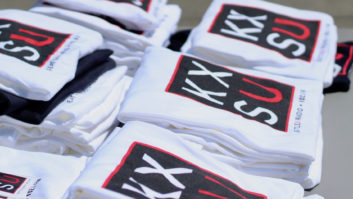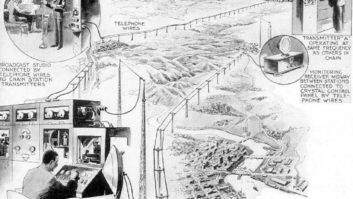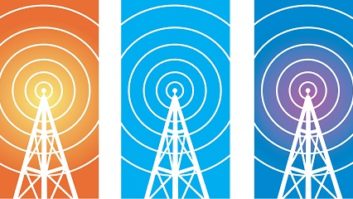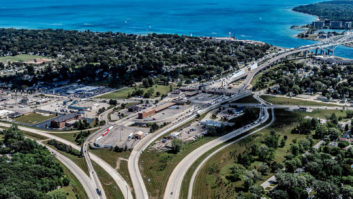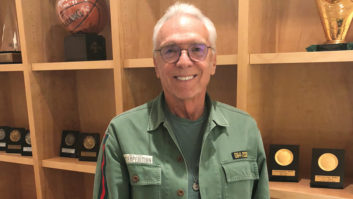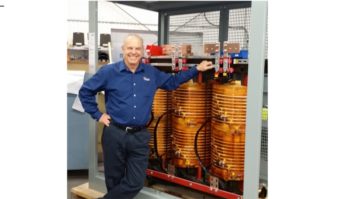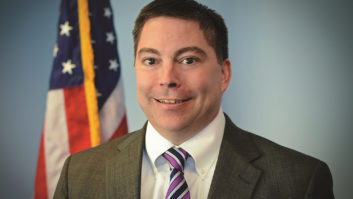The author is chief volunteer, WHCP(LP), Cambridge, Md. Read other articles in this series: This LPFM’s Time Has Come, WHCP Rolls Out Calendar to Raise Funds, WHCP(LP) Is on Target for Sign-On and Ready for Liftoff: WHCP Hits the Airwaves.
Since WHCP’s July 4 sign-on a year ago, we have been enjoying the thrills and chills of all start-ups. Each day we escalate community engagement, hone procedures, grow local programming and raise funds through underwriting and memberships.
The first 100 days witnessed inevitable shakedown tribulations and painfully long days; but since then we have been focused on quality forward momentum. Patience and persistence in achieving goals and creating a shared vision are paying dividends.

Alyson Farnell is host of the “Awesome Aly Hour” and the station’s first Chesapeake College intern.

Donations of equipment and services came from around the country.Lesson One — Start Earlier
The maxim “there are three ingredients to every big project: time, quality and money” is spot on. “Pick two” and the other one will have to give. Naturally, we didn’t want to sacrifice quality or have surplus cash to throw at a healthy list of needs, so time had to give.
Even though we used 17 months of our 18-month CP we should have started in earnest sooner. I made that conscious choice. After commencing retirement I took six months to refurbish the barn out back (WHCP’s studio during experimental operations), and to decompress from 45 years of 60-hour work weeks.
With a year to go on the CP, I focused seriously on a much bigger buildout than originally planned thanks to innumerable donations from colleagues around the country. The station would not just be an iPod loop coming from the barn; those donations obligated us to build a full-service community station downtown.
I was daily reworking wiring diagrams as more equipment arrived as donations or low-cost eBay or Amazon purchases — guided by user insights courtesy of the PubTech listserv. This was key to saving money and achieving good air quality.
Lesson Two — Beware the Software
A daily challenge is the number of software tools that have to be mastered by all-volunteer staffs quickly — and the seemingly infinite array of incompatibilities between applications and operating system versions. The vagaries of hardware differentiation and code-monkey-designed software with scant user testing can be a challenge.
Broadcast technology is the easy, and most reliable, part. Our Nautel VS300 transmitter has never had a hiccup. And the 30-year-old PR&E consoles from Wyoming Public Radio have been rock-solid. The $200 Ubiquiti NanoBeam 5 GHz link has similarly been flawless and gets my vote as “best bang for the buck.” Audacity has served admirably as the free daily production tool, with amazing capabilities that we are still learning.
Too often, vexing behavior between applications and across the Windows universe has consumed precious time. Thus, all-volunteer stations need as many folks as possible conversant with different software tools — and that means youngsters, aka digital natives.

Volunteers John Durkin and Fred Phillips-Patrick install the ubiquity Nanobeam 5 GHz unit at the studio.Lesson Three — Master Your Automation
Your automation system is your most important ally — and you must master it months in advance of going on-air. Although I read the TuneTracker manual, watched the training videos and cranked out logs and playfolder commands that should have worked fine, they didn’t. It took four months to solve what was a subtle hardware incompatibility by moving off of our awesome quad-core server to a reasonably powerful dual-core desktop machine.
Once we moved to the new hardware, everything settled down and has been running quite smoothly. Due to the hardware incompatibility everything appeared normal, but reliability was nowhere to be found. Programs were skipped, programmers were upset and the “chief volunteer” was approaching burnout. We should have “shotgun substituted” to a different computer sooner.
We now have more than 80 unique format clocks across our 168-hour broadcast week. And each of them has dozens of commands whose syntax and pathnames have to be to be concise. Now, the only errors are when Tunetracker does exactly what we instructed it to do instead of what we meant.
You are running behind already if you have a CP and haven’t been testing your air-product off-line.
WHCP bought a TuneTracker system, which some colleagues questioned as an unusual choice. Well, it may be less well-known, but I’m convinced it is unusually good on key points: elegance, price, integrated live features and a pleasing user interface (we stare at this baby scores of hours each week, so it matters). No kindergarten color schemes and mechanics.


Have laptop, will travel — Tunetracker offers a near-studio-quality remote system option called SignalCaster. We’ve done daylong remotes using just a laptop and the hotspot on my iPhone. Call in via Skype, log in via VNC Viewer and you are on the air in seconds with the full 40,000-song library at your fingertips and live-assist control over all broadcast elements.
Additionally, we are the only station in the market with automated, but human-voiced time and temperature constantly served up by the data from the local airport. TT also controls the Broadcast Tools switcher for live remotes (e.g., city council and “Live Mic” night). FTP provides hourly network news from Feature Story News for only $15 a month, and we take a number of high-quality FTP-delivered programs from PRSS’s Content Depot, as well as using PRX (they both offer special incentives for LPFMs).
Lesson Four — Dollars FirstMeans Community First
All successful organizations need a business plan. For radio that means purposefully planning integrated activities that build in underwriting support as you go. The three pillars for us are memberships, underwriters and donations.
Last year we issued a missing resource: the Cambridge Community Radio Calendar. Local award-winning photographers submitted their works and the result was a stunning “community debut.” We gave the local retailers an incentive: Give us the $12 collected for each calendar and we’ll give you $12 in underwriting during our first year on the air. This was a two-fer that helped us sign on with a nice fleet of underwriters. That helped to get others joining the community radio movement. We have recently achieved “sold out” status at 27 underwriters, which keeps on-air acknowledgements to only 3 minutes per hour. All sponsors rotate across the schedule and we charge a mere “dollar a holler” for $100/month. Dollars first means always saying Yes! to requests for coverage and publicity and local musician airplay. It’s the time-proven formula for radio success: community engagement.
Lesson Five — Have Fun!
At any “all-volunteer” community radio, no one will continue to contribute if it’s not fun.

It’s fun to share a passion for great music. It’s fun to ask interesting people about their work in the community. It’s fun to help build community.
In fact WHCP’s mission is “We Help Cambridge Prosper (WHCP).” Morning man Bruce Patrick came up with that while cutting lawns (his day-job that subsidizes his role as a terrific morning DJ and PD). His enthusiasm and love for the community come through as strongly as his wacky sense of humor.
Contributing to community? That isn’t really work, it is great fun — as well as a privilege.
NEXT UP
The County Board of Supervisors recently accepted our token bid for a 1,300-square-foot house on the main street not far from the high school that will provide the home for our Student Training Center and the MidShore Radio Reading Service. The building needs paint, a floor repair and lots of touch-up work (it’s been vacant and on the tax delinquent rolls for many years). But we’ve already purchased five more BMX IIs on eBay that await uncrating. By fall, this important new addition to our community should be online.
Our first Youth Training Class with the local YMCA is scheduled for August and as I write, we have the first five high school interns signed up for summer. Already, WHCP’s first Chesapeake College intern, Alyson Farnell, now produces our top ranked weekly local music show “The Awesome Aly Hour.” We can’t wait to hear what great radio these new youngsters will also bring to the airwaves on “101.5 FM, WHCP(LP) in Cambridge, M-D, A Great Place to Be!”
Read Mike Starling’s past articles about building this low-power station at radioworld.com, keyword “WHCP.”
Starling is former chief technology officer and vice president for engineering at NPR Labs and past chief engineer at KPBS(FM) in San Diego and WKYY(AM) in Amherst, Va.





